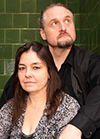Triggering of paradoxical sleep with gamma-hydroxybutyrate (GHB) in the rat is blocked by the GHB receptor antagonist NCS-382
Gamma-hydroxybutyrate (GHB) is a naturally occurring fatty acid thought to act as a neurotransmitter in the mammalian central nervous system. We have previously shown that a low dose of GHB administered early after the onset of the light period significantly decreases the latency to PS in the rat.1 The aim of the present study as to verify whether this effect of GHB would be prevented by a pretreatment with the specific GHB receptor antagonist NCS-382 administrered in the same rats.METHODS.
Six male Sprague-Dawley rats weighting 250 9 at the time of surgery were implanted with chronic EEG, EOG, and EMG electrodes; following surgery, they were habituated for one week to the recording environment and equipment. Animals were housed individually in recording cages with free access to food and water; lights (mean = 60 Lux at floor level) were turned on at 06hOO and a 12:12 light-dark cycle prevailed. Each rat was exposed to four levels of treatment, administered either at the begining (08hOO) or in the middle (14hOO) of the usual main sleep period: GHB 10 mg/kg, NCS-382 10 mg/kg, GHB + NCS-382, and control. Fresh solutions were prepared for each experiment; drugs were dissolved in physiological saline (1 ml/kg) and were injected i.p. Experimental recording sessions were performed on two rats at a time: one rat was submitted to an active treatment while the other rat received an equivalent volume of the vehicle. Recordings were scored blind with regards to the experimental condition, using 10 sec epochs; recording speed was 15 mm/sec. Variables were defined as follows: Sleep onset latency = interval between injection and the first epoch of any sleep stage. Latency to light Slow Wave Sleep (SWS-1) = interval between sleep onset and the first sleep spindle. Latency to deep Slow Wave Sleep (SWS-2) = interval between sleep onset and the first epoch with 2 50% of delta waves. Latency to PS = interval between sleep onset and the first epoch with desynchronized EEG, atonic EMG, and rapid eye movements. PS fragment= sequence of uninterrupted PS epochs. Sleep period time = interval between sleep onset and the last epoch of sleep before the end of the recording. Wake time after sleep onset (WASO), SWS-1, SWS-2, and PS were calculated for the whole and for thirds of the sleep period time. Results are expressed in minutes (except PS fragments, in number) as means ± s.e.m. Comparisons between active treatments and the saline treatment were made using paired t-tests.
RESULTS.
Latencies. Sleep latency and latency to SWS-1 were always equal so both variables were pooled into the former. As shown previously1, GHB at 08hOO significantly decreased the latency to PS (53.5 ± 10.2 vs 24.0 ± 4.8; p < .02). SWS-2 latency was non significantly decreased (27.6 ± 11.7 vs 19.9 ± 13.4) and sleep latency was not affected (37.5 ± 14.8 vs 37.0 ± 7.8). GHB at 14hOO had no significant effect. NCS382 did not have any effect of its own on sleep parameters. When NCS-382 was co-administered with GHB, the facilitating effect of GHB on PS latency was no longer present (see Figure). Durations sleep stages. For the present abstract, only durations following the administration of GHB at 08hOO were analysed. No significant differences were found for WASO (29.9 ± 12.2 vs 30.9 ± 6.1) and PS (33.0 ± 4.8 vs 30.9 ± 3.1) but SWS-1 tended to be increased (78.8 ± 17.4 vs 101.3 ± 7.7) and SWS-2 tended to be decreased (81.3 ± 15.9 vs 62.3 ± 2.9). PS fragments. Absolute number of fragments as well as number of fragments per minutes were not affected by GHB (range: 0.07 to 0.09 PS fragment/minute).
DISCUSSION
This report shows that the facilitation of PS by GHB in the rat can be blocked by the specific GHB receptor antagonist NCS 382. Previous results have shown that low doses of GHB (5-10 mg/kg i.p.) increase cortical unit firing2 and increase core body temperature3 while higher doses (160-320 mg/kg, i.p.) have the opposite effects.2,3 It was also shown that administration of NCS-382 selectively reverses the physiological effects induced by low doses of GHB.2,3 These results suggest that the early night facilatatory effect of GHB on PS latency in the rat could be due to a selective activation of GHB receptors. We are presently analysing the specificity of SWS facilitation by high GHB doses delivered in "later night"'.
- Girodias V, Godbout R, Webster HH. Sleep-inducing effects of gamma-hydroxybutyrate according to dose and time of administration in the rat. Sleep Research, 1995; 24A: 24.
- Godbout R, Jelenic P, Labrie C, Schmitt M, Bourguignon JJ. Effect of gamma-hydroxybutyrate and its antagonist NCS-382 on prefrontal cortex firing in the rat. Brain Research, 1995; 673: 157-160.
- Godbout R, Rompre PP, Schmitt M, Bourguignon JJ. Dose-effect of gamma-hydroxybutyrate on rectal temperature in rats: hyperthermia is blocked by the GHB receptor antagonist NCS-382. Sleep Research 1993; 22: 24.


